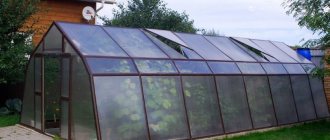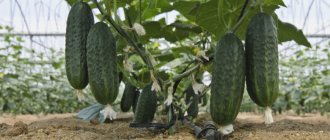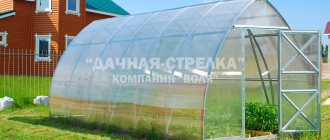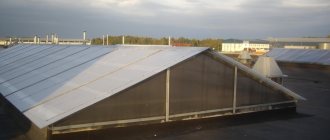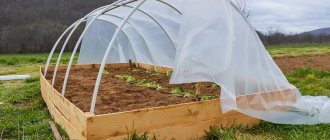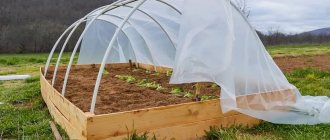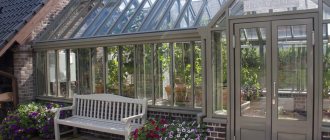Until recently, gardeners were rarely concerned with the question of how to cover a greenhouse, because there were only two options - polyethylene or glass. With the expansion of the agricultural market, when new materials, still untested by long-term practice, appeared, the choice became more difficult. Which one has the proper strength and durability, holds heat well, and is quite inexpensive? And do the new products have any negative aspects that manufacturers are silent about, but a vegetable grower should definitely know?
The yield depends on the quality of the covering material
Types of coverings for greenhouses
How to cover a greenhouse for growing crops in artificial conditions? The range of covering materials is diverse. The most popular shelters are:
- glass;
- film;
- polycarbonate
Recently, spunbond has proven itself well. This is a non-woven material. It is durable, reliable and multifunctional. It transmits light and oxygen well. Plants feel comfortable under such cover.
How to cover the greenhouse - with film, glass, polycarbonate or other material - each gardener must decide for himself, based on a number of certain conditions.
Non-woven polypropylene fiber
Otherwise called agrofibre or agrotextile, since this is their direct scope of application and they “went” to the private sector from industrial greenhouse complexes. In this segment, the domestic manufacturer did not disappoint, and nonwoven materials are represented by both ours and foreign brands that have become household names - Lutrasil, Agrospan, and other brands. The technology itself for producing non-woven fabric from a melt of polymers is called spunbond, by analogy, all non-woven fabric as such is also spunbond, no matter who and wherever the material is produced, but today it is also one of the most popular brands. But in fact, there are no fundamental differences between different brands and all these are non-woven agrotextile materials, within the type differing only in density, color and specialization. That is, it is not so important whether it is spunbond or a covering material from another manufacturer; it is much more important to follow the rules of application related to the quality parameters of the fabric. The most important of them is density, which varies over a wide range.
- Light: 17-30 g/m² - the thinnest “web” with increased permeability, but quite capable of protecting plants from pests (try piercing a sunflower in gauze, and this is even cooler), and from summer fire, and from small ones (up to - 2 ˚С) return frosts. The canvas in this density range is light but durable; it is used to cover shrubs; it is used to make shelter for vegetable and berry crops by simply throwing it over plantings and securing it from the wind. But it is not intended as a covering material for arcs, and it is not capable of protecting beds from weeds, and this is not required of it.
- Medium: 42 g/m² - a universal group of materials intended both for constructing greenhouses on metal or composite arcs, and for protecting plants in winter. In a greenhouse with medium-density covering material, plants will be reliably protected from frost down to -6 °C, which allows you to get the earliest harvests of not only green vegetables, but also other garden crops. Seedlings, shrubs, perennial flowers that need shelter and other species are also wrapped in canvas. A greenhouse with covering material reliably protects against freezing and external influences, but allows light and air to pass through well.
- Dense: 60 g/m² - not only dense, but also quite weighty non-woven covering materials, intended primarily for mulching and covering heat-loving crops in winter. The canvas will keep you warm inside even at -10 ˚С, which is especially important in cold regions. Due to the weight, simply wrapping the plants is not an option; you will need a wooden or metal frame. This category is also actively used to cover greenhouses and greenhouses, including by participants of our portal.
Tatyana331 FORUMHOUSE participant
Our greenhouse is covered with agrospan 60. It’s quite good, the material hasn’t suffered during the year, I think it’ll be enough for a few more seasons. In the spring, they additionally covered the arcs with a layer of agrospan, but in the summer the plants did not overheat as in a glass greenhouse. But it lets water through.
Which is quite natural, since a non-woven covering material, even in arcs or on a frame, is still not a film and is not intended to create a sealed contour; it has a lot of other advantages.
meloman54FORUMHOUSE member
My neighbor installed Agrospan 60 on his homemade arched greenhouse, attaching it to the frame with narrow wooden slats. The end planes are decorated with polycarbonate. The material is dense enough to protect plants from sudden spring cold snaps, but it “breathes”, there is no danger of overheating in the heat, and there is no need for shading. The fact that water passes through is just normal and even desirable. Watering yourself can be problematic, especially if the owners come only on weekends.
And one more thing: the density of the material did not allow the holes from the nails under the slats to crawl into holes. The cover was removed for the winter, now, in the spring, it was put back on again, nailed down in the “traces” of last year’s holes. Choose dense agrospan; it will last for more than one season, even with such fasteners. Clips are a more gentle method of fastening, but also more expensive and scarce.
In addition to density, agrotextiles also differ in color; there are two main categories.
- White covering material can be light, medium or dense, and is used for its intended purpose based on density, with the difference that white spunbond or agrospan, even 60 g/m², is not used for mulching. But it feels great on permanent greenhouses and frames for winter shelters. And for mobile greenhouses on arcs, 42 densities are sufficient; such material will be cheaper, there will be no special load on squat structures and it will last for several seasons.
- Black covering material is only dense, as it was originally intended for mulching and creating conditions unsuitable for weeds due to its harsh greenhouse effect. Also, black agrotextiles (polyethylene) are used to “warm” the soil before planting crops, for which purpose a fabric of the desired size is pulled over the cultivated (dug up) area or directly onto the beds and tightly fixed at the edges. The material attracts the sun's rays during the day and prevents heat from escaping at night, resulting in intense heating of the soil. As soon as the air temperature reaches the desired values, you can begin sowing, rather than waiting another week or more until the ground also warms up enough. If such preparation is redundant for the southern regions, then for Moscow and similar climatic zones it is just in order.
Recently, two-layer nonwoven materials, both black and white and in other variations, have appeared on sale, but it does not make much sense to consider this covering material separately, since ordinary white and black nonwovens are sufficient to obtain the desired effect. Green non-woven fabric, intended for decorating and protecting tree trunks and flower beds, is also not the most popular product.
Greenhouse glazing
Glass has been used to cover greenhouses since ancient times. This is completely justified, since it has many positive properties:
- High light transmittance of 94%.
- Long service life.
- Resistant to temperature changes.
- High thermal insulation qualities.
- Resistant to chemicals, abrasives and detergents.
But in addition to its positive qualities, glass has a number of disadvantages, due to which many gardeners have abandoned its use. Among them:
- The need to create a strong frame, because a fragile base is not able to support the material.
- Significant material investments.
- Fragility of the material.
- Penetration of ultraviolet rays.
The procedure for covering a greenhouse with glass itself requires certain knowledge and is quite complex. Not every gardener is able to glaze a greenhouse on his own, without resorting to the help of specialists.
For glazing greenhouses, you should choose absolutely smooth, transparent glass. Its thickness must be at least 4 mm. Translucency directly depends on the width of the frames: the larger they are, the better conditions are created for plants. When choosing the width of the frame, you should also take into account the fragility of the glass. On a large glazing surface it will be significantly higher. If the glass is damaged, repairing the greenhouse will cost more than using other materials.
What is the advantage of covering greenhouses made of reinforced film?
The Agrochekhol company offers several types of greenhouses and reinforced covers, but all of them are made using reinforced three-layer premium polyethylene, with a density of up to 250 microns. This equipment provides comfortable conditions for plant growth, promotes good yields, and also allows the greenhouse to be used for 10-12 years. Film and polycarbonate greenhouses are actively being replaced with reinforced material, as they see more advantages in them than other types of coatings.
The main advantages of reinforced covering material:
- The high tear resistance of the material increases its wear resistance.
- The cover is put on the prepared frame very quickly and is conveniently fixed to the base of the frame.
- When used during the season and dismantled for the winter, the service life extends to 10 years.
- Light weight is an advantage for easy transportation, as are compact dimensions when folded.
- Affordable price and high quality are important aspects when choosing greenhouse covering material.
- Resistance to mechanical damage and the possibility of restoration if an accidental puncture or cut is made.
- Wide range of temperatures, does not melt in the scorching sun, does not crack or tan at low temperatures.
- The finished cover is equipped with zippers on the doors and windows, thanks to which ventilation can be arranged and it is convenient to use.
- Dense material withstands gusts of wind, heavy rain and hail.
- Plants and the material itself are not afraid of ultraviolet radiation, the soil does not dry out, the leaves do not fry, and there is always enough light for the plants.
Application of film
How to cover the greenhouse so that the plants feel as comfortable as possible? One of the most common and cheapest materials is film. Greenhouses covered with it turn out to be practical. However, this coating has a short service life.
Often condensation collects on the inside of the film, which creates favorable conditions for the spread of various diseases, bacteria and dirt that are unsafe for agricultural crops. Despite this, the film transmits and scatters light well, but only as long as its structure is not damaged. Despite the obvious disadvantages of covering material, gardeners do not stop using it. Three types of film are popular:
- polyethylene;
- polyvinyl chloride;
- reinforced
The first is the cheapest, but very short-lived. It's enough for the season. The second one is more expensive. With proper care it will last up to 7 years. The service life of the third film is three years. How to cover a greenhouse with film with your own hands will be written later in the article.
Characteristics and features of reinforced film
Covering greenhouse made of reinforced film from the Standard series, demonstrates a density of 250 microns. The coating is made of 3 layers, one of which is reinforced, located in the middle. It is this that strengthens the material, giving it strength and durability. Visually you see a checkered film with cells filled with polyethylene. Also, special impurities have been added to the composition to improve the properties of the material. This results in a favorable microclimate inside the greenhouse; the plants are protected from UV rays, but at the same time receive enough light for normal functioning.
All the advantages of reinforced covers:
- Resistance to temperature changes varies widely, from -400C to +900C.
- The micropores present in the cells establish the necessary air exchange necessary for plant respiration.
- Inside the greenhouse, condensation does not collect on the material, which often happens with polyethylene.
- During the manufacturing process, impurities are introduced to provide a light-stabilizing and reflective function. This reduced the negative effect on plants and increased the service life of the reinforced cover.
- In case of punctures or cuts, the material can be repaired, the defect is not distributed over the entire surface, and is quickly eliminated.
- Reinforced material does not rot, it is not prone to mold formation.
- The advantages include simple installation and dismantling, convenient transportation from place to place.
- Light weight and plasticity allow the case to be compactly folded and transported even on a bicycle.
- The property of light stabilization is present throughout the entire service life.
Advice! If you do not yet have a greenhouse frame, experts advise building or buying a standard size - 3X4 or 3X6. This way you can quickly buy a covering cover; you don’t need to order it, wait a long time, or overpay for custom sizes.
Covering the greenhouse with film
Before covering the greenhouse with film, you need to calculate the amount of material. To do this, measure the total length of the structure frame and divide it by the width of the film. Ten percent around the entire perimeter is added for overlapping material and its fastening. The number of canvases is multiplied by their length - and the required length of the material is obtained. We should not forget about the ends, the size of which must be added to the calculated figure.
How to properly cover a greenhouse with film? This is not difficult to do if you follow certain rules:
- The material should not be cut in advance. First you need to throw the roll over the greenhouse, stretch the film and add about 25 cm on each side to secure the shelter. Only after this can the canvas be cut off. This is how you should cut all the canvases.
- The film is laid on a flat surface and the sheets are glued together with transparent tape on both sides.
- Parts for the ends of the building, doors and windows are cut out with allowances for fastening.
- To avoid sagging and strong tension of the covering material, it is installed in moderately warm weather. There should not be strong wind outside.
- For longer operation of the canvas, the greenhouse is covered shortly before plants are planted in it.
The frame of the greenhouse is made from the cut out parts. Place it on the structure and secure it at the base. The reinforced film is pressed down with timber and covered with earth on top. A plastic film glued with tape is pulled over the frame. The edges of the canvas are stretched, a long strip is placed on top and secured with nails. After the main part of the structure is covered, the ends, doors and windows are installed. All joints are connected with tape. If the greenhouse is made of plastic and metal tubes, then the material is attached to it with clamps of the appropriate diameter.
How to quickly build a greenhouse with arcs (with photo explanations)
As a rule, the first greenhouse in a country house or garden is made from inexpensive materials: you need to try what it is and evaluate how profitable the idea is. Hence the requirements: a simple, prefabricated structure made of inexpensive, accessible materials. These requirements are fully met by frame greenhouses with arcs made of PVC pipes (HDPE can also be used).
This greenhouse on arcs made of PVC pipes is assembled by one person in 3-4 hours.
Materials
A greenhouse like the one in the photo above can be made in a few hours. You will need the following material:
- Board for the base, size at least 75*40 mm, length depends on the dimensions of your greenhouse. A frame is made from timber, which lies around the perimeter of the greenhouse. If the greenhouse is 6*3 meters, then 18 meters of timber are needed, if 8*3 m, then 24 meters, etc.
- Board with a section of 50*20 mm for organizing the front door.
- PVC pipes with a wall thickness of at least 2 mm. The length depends on the dimensions of the greenhouse. If you are going to build a greenhouse, then at the top point its height should be at least 2.2 meters. Then you can work inside without any difficulty.
- Reinforcement with a diameter of 14-16 mm. It should be slightly smaller than the internal diameter of the PVC pipes.
- Covering material - film or agrofibre. Others will not be suitable for this design.
- Perforated metal strip.
- Wood screws.
Before using wood, treat it with anti-rot and insect repellents. If there are pieces of bark somewhere, you need to get rid of them. This is where most of the larvae are. If there are any factory impregnations, you can use them. If you have used machine oil, it will do. If this is not there, you can burn the wood with a blowtorch. This method is unreliable, but even such processing is better than no processing.
Tools for work
To make a greenhouse for your dacha with your own hands you will need the following tools:
- hammer, nails;
- wood saw;
- grinder with a metal disc;
- sledgehammer or heavy hammer (to hammer in reinforcement);
- screwdriver
We are building a greenhouse from polypropylene pipes (photo report)
First of all, the site is marked and then leveled. It is leveled. Next, the actual construction of the seasonal greenhouse begins.
Preparatory work
A rectangle is knocked out of a wide board, which outlines the border of the greenhouse. If you know how, you can connect the timber into a paw; if not, just knock it all the way through with a hammer and long nails (at least 10 cm). Reinforce the corners with metal plates or corners. We check the basis. To find out how smooth it is, measure the diagonals. If they are equal, great. No - level it. After this, we fix the base - we drive in reinforcement rods in the inner corners. They will hold the base in place.
These rods prevent the base of the greenhouse from moving
The reinforcement is cut into pieces about 80 cm long. They are installed every 50 cm on both long sides of the greenhouse. 40 cm are driven into the ground and the same amount remains sticking out. The rods of opposite sides must be strictly opposite each other, otherwise the greenhouse will be skewed.
Pieces of reinforcement are driven in on both long sides
We put on the arches
We put a cut piece of polypropylene pipe on the reinforcement on one side, bend it and put it on the same rod on the opposite side. The result is the first arc. We do the same with everyone else. We get arcs installed every 50 cm. This is a greenhouse frame made of polypropylene pipes.
Pieces of PVC pipes are put on the fittings
Now the pipes need to be fixed. Otherwise, they will come off just as easily as we installed them.
We take a perforated metal strip, a screwdriver, and wood screws. We cut a piece of tape, attach it on one side to the frame near the pipe, then on the other. You can screw in one more or two self-tapping screws closer to the pipe so that the arc is held securely. To make the fastening stronger, it is better to take corrugated fittings rather than smooth ones; you can also fix the PP pipe twice: almost at the ground and closer to the upper edge of the frame.
The pipe is attached to the base beam using perforated metal tape
Now we need to connect all the arcs with longitudinal pipes. They will add rigidity to the structure. If the greenhouse is small, only one longitudinal rib is enough. But it’s more convenient when they are also on the sides.
A long piece of PVC pipe or a beam of small cross-section is tied at the top in the middle of the arch. It is attached with a plastic clamp to each arch. It will give the structure additional rigidity.
Plastic clamps - universal fasteners
Making doors
A doorway is made from narrower boards in the middle of the first arch. Its height and width depend on how tall your greenhouse is. But the door width should not be less than 80 cm: walking will be uncomfortable.
And this is what has already happened: the greenhouse is almost ready
Now all that’s left to do is choose what to use and cover the greenhouse. PVC pipes can carry film (any) or non-woven material (or both of these materials). After the material is fixed, you can consider making a greenhouse with your own hands complete: you can plant the seedlings. The height is enough to grow even tall varieties of tomatoes or cucumbers, and you can easily make supports for tying.
Greenhouse using the same technology
The interesting thing is that using the same technology it is easy to build a greenhouse. Only its dimensions will be smaller (the reinforcement may be thinner, its pieces smaller), and the whole technology will be similar.
A greenhouse made of PVC pipes using the same technology with minor changes: since it is small, the pipes are nailed directly to the wooden frame. And the top pipe is on top and taped with electrical tape (can be replaced with tape).
The Snowdrop greenhouse was practically built in the same way. The only difference is that the covering material is stitched in it, drawstrings are made in it, into which PVC pipes are threaded. After they are installed in the required places of the agrofibre, they are stuck into the ground. Why is such a greenhouse convenient? Because the shelter can be moved along the arch, opening or closing the plants as needed.
Read about other types and types of greenhouses here.
Improvements
The most questions arise when organizing the entrance: this turns out to be the most problematic part. Here are two options for solving it:
- Use thin plywood and a timber frame.
The result is a lightweight but reliable design - Cover everything with plywood, and so that its edges do not tear the film, it is covered with felt, thin foam rubber, or just a strip of soft fabric.
How else to make an entrance to an arched greenhouse
To prevent the edges of the plywood from tearing the film, they are covered with something soft
How to attach film to pipes
What are the benefits of PVC pipe arches? They are smooth, the film and spunbond on them do not tear. But how to attach the film to them? You can’t hammer a nail into them; you can screw a self-tapping screw into them, but only into something lying on the ground. It “plays” in the frame and the screw does not screw into it. There are special plastic snap clamps for attaching the film. They are placed on top of the film and cover part of the pipe.
Special clips for film greenhouses for fixing on arcs
From a hose, plastic pipe, or other available materials
Such clamps can be made from scrap materials. For small arc greenhouses, a piece of old hose cut lengthwise is suitable. For greenhouses, its rigidity may not be enough: the windage is greater. Then the clamp can be made from a piece of the same plastic pipe. It is also cut lengthwise, but you will have to cut off some of the width: PVC and HDPE are still quite rigid, and you can’t just unroll them. Determine which part of the pipe to cut out experimentally, then sand the edges so that they do not tear the film.
Pipe clamps, which are used when installing pipelines in homes, do a good job of holding the film. You'll have to break off his leg, but otherwise he's very good.
People also use office binders of the appropriate size. This device holds well, but due to the fact that it is metal, there is a possibility that the film will tear in a strong wind. To prevent this from happening, you can place a piece of fabric.
How else can you fix the film on the meadows of a greenhouse or greenhouse?
And one more way you can attach the film to the arc of the greenhouse: take double-sided tape and stick it with one side on the pipe. Then, gradually removing the protective film, stick the film to it. This is an option for cheap plastic film: it will be impossible to remove it. One more point: you don’t need to glue the film all the way to the bottom: after all, you may need to ventilate the greenhouse.
For convenient ventilation, the film is cut longer than required by 20-30 centimeters on each side (if the arc length is, for example, 2 meters, then the film will need at least 2.5). They take a block, wrap it in film and nail it. Now, if the film needs to be lifted, it is wound onto a block, and it is secured (or simply thrown onto the roof, tying a rope so that it can be pulled back). Only the block must be well processed, without sharp edges. This way it won't tear the film.
Read about automatic watering systems in the article “Do-it-yourself auto-irrigation”
Application of polycarbonate
Polycarbonate is the most popular material for greenhouses. It is hard plastic. It is stronger than glass, but weighs less. There are monolithic and cellular. The latter is considered the most suitable for greenhouses. Characterized by high thermal insulation and light transmittance. Has a long service life.
The advantages of cellular carbonate include:
- strength;
- complete lighting of greenhouses;
- flexibility;
- light weight;
- long service life (up to 20 years).
Thanks to the positive qualities of the material, many gardeners invariably have the question of how to cover a greenhouse with polycarbonate with their own hands.
Experts advise not to rush and carefully familiarize yourself with all the features of the material. Pay attention to the thickness value. I advise you to take sheets with a thickness of 5 to 8 mm.
Before using cellular carbonate, you should pay attention to the fact that when heated, it expands. When heated, a six-meter sheet increases by 5 cm in length and 2 cm in width. Therefore, the greenhouse should be covered at a temperature of at least +10 °C, while the polycarbonate blocks are mounted overlapping.
Glass
Glass is a material that has stood the test of time, because initially greenhouses, hotbeds and conservatories were made exclusively from it. This material has many advantages, but... some of them are also disadvantages.
It’s worth starting with the fact that glass transmits 100% of sunlight. Which is very useful on cloudy days, but harmful on sunny days. Plants in such a greenhouse can overheat and even die.
To remove excess heat and additional ventilation in the greenhouse, it is necessary to make vents in the roofs or on the walls
Greenhouse made of tempered glass
Another significant point is the large mass of glass. So, the weight of 1 m² of sheet with a thickness of 5 mm is 12 kg. On the one hand, this requires the construction of a foundation (at least a columnar one) and a strong frame. On the other hand, the result will be a stable, high-quality structure that will last for many decades. And when the supporting profiles do become unusable, they can be replaced and old glass installed. After all, this material has no expiration date.
By the way, due to the fact that glass does not deteriorate over time, another, this time undeniable, advantage follows. To build a greenhouse, you can use “recycled” glass from obsolete windows and other translucent structures. This will reduce the cost of the seedling house. New glass will cost 500 - 650 rubles/m².
The glass is easy to clean, which means it is easy to maintain. In fact, just an occasional wash with garden slurry is enough. Heavy stains can be removed using non-abrasive cleaning agents.
When in contact with fire, glass does not melt and does not release toxic substances, which cannot be said about polycarbonate
The greenhouse frame in its simplest form is a structure made of steel profiles and rubber inserts. But if you use plastic or “warm” aluminum profiles, you can assemble a sealed capital structure from glass - a heated greenhouse or winter garden.
Now let's move on to the cons. First and foremost: glass breaks. This leads to problems during transportation and installation. And even a strong hail can turn a greenhouse into a pile of fragments.
It is also worth noting the high thermal conductivity of glass. In simple terms, it heats up quickly (as we already discussed above) and cools down quickly. As soon as the sun goes behind the clouds, the temperature in the greenhouse immediately drops. All other things being equal, this design is cooler than polycarbonate, and the crop in it ripens 5-7 days later.
And finally, glass has rather limited architectural possibilities. The optimal design of a greenhouse would be a simple rectangular house with a pitched roof. Theoretically, glass can be bent to the desired radius (this is done in production by placing a translucent sheet on a metal template and heating it in an oven), but the price rises too high. And it will be much more difficult to bring such a panel to the object than a flat one. So if you want to decorate your site with an interesting greenhouse, it is wiser to resort to polycarbonate.
How to properly cover a greenhouse with polycarbonate?
Standard polycarbonate sheets have a width of 2.1 m and a length of 6 or 12 m. All dimensions of the frame gables are transferred to the material, and then all parts are carefully cut out with a jigsaw. Sometimes the question arises which side of the polycarbonate to cover the greenhouse with. During installation, sheets are laid only with the correct side out, vertically. Otherwise, the light transmission capacity will decrease, which will further affect the cultivation of crops.
After all the parts have been cut out, the greenhouse is installed, which is divided into:
- point;
- profile.
With point installation, the material is attached directly to the frame using thermal washers. Holes are drilled at the fastening points. Polycarbonate is applied to the frame and secured with self-tapping screws. Upon completion of installation, all ends are covered with an end profile using thermal insulation tape.
With the profile method, sheets are inserted into special profiles for carbonate and pulled through. Drill holes for self-tapping screws, which secure the covering material. The rafters are glued with thermal tape.
Specifics of using covering materials and main varieties
Initially, before the advent of non-woven fabric, polyethylene film was widely used as a covering material for constructing greenhouses and greenhouses. Depending on the region, such agricultural technology either made it possible to obtain early harvests, or was the only possible way to grow garden crops (cold climate). With the advent of non-woven polypropylene fabrics, not only frames and arches with covering material became available, but also other possibilities.
- Protection from pests (insects, birds).
- UV protection.
- Plant protection in winter.
- Protection against return or early frosts.
- Weed protection.
- Increasing crop yields.
- Creation of optimal moisture balance.
- Reduce watering.
By choosing the right material, you can significantly reduce labor and time costs, and even reap an excellent harvest.
Once upon a time in villages, seedlings planted in open ground were covered with large burdock leaves, changing them as they dried. Fortunately, now, instead of the “handicraft” method, there is a large selection of specialized artificial protective materials. It is not advisable to consider cellular polycarbonate within the framework of this review, since although it belongs to covering materials, it is still more of a facing material and is used for permanent greenhouses. And all the varieties of universal covering materials available on the market can be divided into two main categories.
- Polyethylene film.
- Non-woven covering materials.
Until recently, polyethylene film was poorly represented and there was little choice, but now it is a broad category that unites several types. Like non-woven covering fabric, it is divided into a large number of subcategories with their own characteristics and specific application.
Spunbond
One of the popular materials for greenhouses is spunbond. This is a non-woven fabric consisting of polymer extruded fibers. It is ideal for covering greenhouses. Transmits light and provides free access of air, uniform distribution of both moisture and heat. Helps maintain a stable microclimate. Characterized by optimal thermal insulation properties. Practical and durable. Resistant to frost, chemicals and the influence of bacteria and mold. Safe for plants. Can be used all year round.
This material comes in three types:
- for open ground;
- for covering greenhouses or greenhouses;
- for mulching the soil.
The first two types are white, the last is black. Spunbond for covering greenhouses has a density of 30-60 g/sq. m.
Working with aero fiber
Much has already been said about how to cover a greenhouse with your own hands. Installation of aerofiber (spunbond) is similar in its technology to covering a greenhouse with plastic film. In addition, there are some tricks when using non-woven material:
- Sewing a strip of fabric in the center of the canvas, which has ropes for tying the covering material to the frame of the greenhouse. This greatly simplifies the installation of spunbond.
- To make the canvas fit more tightly, the outside should be covered with thin wooden slats.
- The material can be combined with PET film. Some gardeners make only a roof out of aerial fiber, others construct inserts of a certain width and at a given distance.
- If the greenhouse is of an arched type, then it is not necessary to remove the aerial fiber for the winter.
- Spunbond, which is unsuitable for covering a greenhouse, can be used to protect plants in the winter.
The non-woven material will provide the plants with proper ventilation and watering, and if you use it for mulching, there will be no need to weed the plants. Spunbond also helps maintain a constant temperature in the greenhouse and regulates atmospheric humidity. Accelerates the ripening of fruits in the greenhouse and makes the growing season of crops longer.
In which cases which material is better?
The choice of covering material depends on the specific situation; if there is a shortage of financial resources, polyethylene film is considered the best option.
If you have a sufficient budget, it is recommended to use glass or polycarbonate. Agrofibre and spunbond provide an ideal microclimate in the greenhouse; it is recommended for use by gardeners who rarely appear in the garden.
In any case, the plants must receive everything they need for a good harvest and stable growth.
The purpose of the greenhouse also plays an important role; if the structure is intended for short-term use (to protect seedlings before subsequent planting), film is suitable.
When building a greenhouse that is planned to be used in standard mode, it is recommended to use cellular polycarbonate.
The size of the greenhouse is also important; a small structure can be covered with film annually; when constructing large structures, it is better to use polycarbonate and glass.
When building a greenhouse, it is also important to take into account that it is not recommended to grow the same crop every year in one place, so you will have to either move the greenhouse to another place or change the plants.
Beginning gardeners should not build large greenhouses at first; the best option for this case is a sectional design with the possibility of attaching sections in the future.
Unpopular coatings
In addition to the above materials for the greenhouse, gardeners also use other fabrics that have certain properties:
- Acrylic (plexiglass). It is particularly durable. Most preferable for northern regions. It has a high cost.
- Polyvinyl chloride. It is made of corrugated sheets. They are transparent and therefore transmit light well. Prevents the penetration of ultraviolet rays.
- Fiberglass. Produced from special polyester resins. It is reinforced. It has low thermal conductivity, as a result of which it retains daytime heat throughout the night.
Each of the above shelters has its pros and cons. What is better to choose is up to the owner of the greenhouse to decide.
Briefly about the main thing
The variety of covering materials both simplifies and complicates the determination of a suitable option for a home greenhouse or greenhouse. When choosing, you must take into account the properties and price/quality ratio, the design of the structure and your own construction skills.
The preferred ones include a variety of film materials with low cost and optimal performance characteristics. Owners most often choose perennial polyethylene, improved with stabilizing additives. Polycarbonate is a popular modern coating for greenhouse structures, but its installation requires construction experience.
Tips for choosing material
Before purchasing a covering material, you should take into account all the nuances of the canvas and ask which material is best suited for certain conditions. The following factors need to be considered:
- shelter area;
- climatic conditions of the area in which the greenhouse will be located;
- period of operation of the structure;
- crops that will be grown in the structure;
- the amount of money allocated for the arrangement of the greenhouse;
- purpose of use of the structure;
- complexity of installation.
When choosing a greenhouse, a gardener can rely on other factors that are important to him.
Agrocovers and ready-made greenhouses in assortment
| Type of material | Name | Standard size |
| Reinforced PP | Agrocover Standard | 3X4 and 3X6 |
| Reinforced PP + covering material | Reinforced agricultural cover | 3X4 and 3X6 |
| Reinforced PP + covering material | Double insulated agricultural cover | 3X4 and 3X6 |
| Reinforced PP + covering material | Reinforced agricultural cover with frame | 3X4 and 3X6 |
| Reinforced PP + covering material | Double insulated agricultural cover with frame | 3X4 and 3X6 |
| Covering material | Agrocase Eco | 3X4 and 3X6 |
| Covering material | Eco agricultural cover with frame | 3X4 and 3X6 |
Advice! Buy a ready-made greenhouse or purchase a cover, it’s up to you. If necessary, you can order tailoring to your sizes. At the same time, the kit (frame + case) is the best solution; there is compatibility, which facilitates installation, use, assembly and increases service life.
Source of the article: https://dachalight.ru/%D1%82%D0%B5%D0%BF%D0%BB%D0%B8%D1%86%D0%B0-%D1%83%D0%BA%D1 %80%D1%8B%D0%B2%D0%BD%D0%B0%D1%8F/
